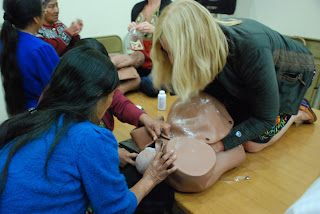Cientos de besos
----------------------
Home Sweet Home
It's late, and I'm tired. I look in on my daughter, fast asleep. She has
hair the color of wheat and is holding on to the dimples on her knuckles
for a little while longer, though she keeps getting taller. She's five. And
one quarter. Which is important when you're 5 1/4. I'm proud of all the
little ways she's making her mark in the world. Though she's shy, she's
making friends in Kindergarten and getting invited to play dates. Though
she's cautious, she knows her abilities well and climbs high into trees.
Though she just learned the sounds of the letters, she writes long
soliloquoys on pieces of printer paper, sometimes creating entire
illustrated books.
She is my inspiration.
She was born just after Mother's Day, and every year on her birthday I
renew my commitment to her, and to the women and girls of the world in her
honor.
All over the world girls grow up without an education, forced to work at an
early age, lacking access to clean water, nutritive food, and medicines. In
many countries they're married off as early as 9 or 10, but frequently by
15. Many of those same places offer very little to protect her from
unwanted pregnancy, and even if a pregnancy is desired, her chances of an
early death, or of losing the child due to complications, are very real.
800 women die every day in childbirth. In the nations with the worst
outcomes, the risk is 23 times higher than it is where I live and was born,
in California.
My daughter and I could have easily been born in one of these countries.
Statistically, we should have been.
But we were not, and so every year I am grateful. And every year I think of
ways I can save the life of another woman's daughter. Or share the gift of
education with another mother or child.
There are many ways this could be done. The challenge is to find the most
effective, and look for partners on the ground to support who will continue
the work. Maybe one day my daughter and I can do this work together. Maybe
someday I will have more than 10 days a year to spend on this work. But
this year something magical happened in just 10 days. Seven women, all of
them daughters, many of them mothers, traveled together with a shared
mission to improve maternal and child outcomes in rural Guatemala.
And I got to be part of this team!
My teammates were incredibly smart and organized, yet so warm and humble.
We partnered with the beautiful comadronas of Totonicapan and surrounding
areas to learn just as much as we were able to teach. We partnered with the
majority-female OB/GYNs and residents of Xela and Huehuetenango who work
incomprehensibly difficult shifts with almost zero resources for the
reasons we all share.
Women like Mercedes, younger than myself but already an accomplished
attending physician, who is pioneering a model that invites the lay
midwives to collaborate with the physicians to improve the health of rural
women. Who spends her rare off hours with her tiny precocious curly-haired
daughter Eva and her mother Norma who brought the ALSO course to Guatemala
years ago for all these same reasons.
Or like Pamela, a second-year resident who lives 2 1/2 hours away from her
7 year old daughter, so she can complete her training in obstetrics. She
sees her child just 3 weekends a year. When she's home it's all about her
daughter. But when she's at work, her life is about saving the lives of
others'.
These are just exactly the sort of women who can change the world.
We worked hard for those ten days. But it was the sort of work that never
feels like work, so full of laughter and relationship-building.
I hope one day I have this sort of opportunity again. I know I'll keep
searching.
But for now I look in on my little daughter and can't believe how much love
there is in the world. One more goodnight kiss. It's good to be home.
--Allison Bacon
I've been struck by the warmth of the welcome we've received here. We've been invited to dinner in family homes as well as restaurants with beautiful night views and been thanked over and over. But best of all, we've received hundreds of kisses, as it's the Guatemalan custom to greet and leave each other and us with a cheek to cheek kiss.
Yesterday was a day where we realized the fruits of our labors. The second year Ob/Gyn resident physicians transformed from students to instructors in front of our eyes. After an often hesitant performance in the workshops the day before, Jacky, America, Feby, and Silvia lectured to their superiors with confidence and then tactfully corrected their errors in the hands-on workshops. These young women are now certified ALSO instructors - I am certain they will put their new found skills to great use. Our hearts were bursting with pride for them!
The girls kissed us all goodbye and we were whisked away to a dinner hosted by the Chief of the Department!
Signing off with muchos besos,
Sarah M
----------------------
Home Sweet Home
It's late, and I'm tired. I look in on my daughter, fast asleep. She has
hair the color of wheat and is holding on to the dimples on her knuckles
for a little while longer, though she keeps getting taller. She's five. And
one quarter. Which is important when you're 5 1/4. I'm proud of all the
little ways she's making her mark in the world. Though she's shy, she's
making friends in Kindergarten and getting invited to play dates. Though
she's cautious, she knows her abilities well and climbs high into trees.
Though she just learned the sounds of the letters, she writes long
soliloquoys on pieces of printer paper, sometimes creating entire
illustrated books.
She is my inspiration.
She was born just after Mother's Day, and every year on her birthday I
renew my commitment to her, and to the women and girls of the world in her
honor.
All over the world girls grow up without an education, forced to work at an
early age, lacking access to clean water, nutritive food, and medicines. In
many countries they're married off as early as 9 or 10, but frequently by
15. Many of those same places offer very little to protect her from
unwanted pregnancy, and even if a pregnancy is desired, her chances of an
early death, or of losing the child due to complications, are very real.
800 women die every day in childbirth. In the nations with the worst
outcomes, the risk is 23 times higher than it is where I live and was born,
in California.
My daughter and I could have easily been born in one of these countries.
Statistically, we should have been.
But we were not, and so every year I am grateful. And every year I think of
ways I can save the life of another woman's daughter. Or share the gift of
education with another mother or child.
There are many ways this could be done. The challenge is to find the most
effective, and look for partners on the ground to support who will continue
the work. Maybe one day my daughter and I can do this work together. Maybe
someday I will have more than 10 days a year to spend on this work. But
this year something magical happened in just 10 days. Seven women, all of
them daughters, many of them mothers, traveled together with a shared
mission to improve maternal and child outcomes in rural Guatemala.
And I got to be part of this team!
My teammates were incredibly smart and organized, yet so warm and humble.
We partnered with the beautiful comadronas of Totonicapan and surrounding
areas to learn just as much as we were able to teach. We partnered with the
majority-female OB/GYNs and residents of Xela and Huehuetenango who work
incomprehensibly difficult shifts with almost zero resources for the
reasons we all share.
Women like Mercedes, younger than myself but already an accomplished
attending physician, who is pioneering a model that invites the lay
midwives to collaborate with the physicians to improve the health of rural
women. Who spends her rare off hours with her tiny precocious curly-haired
daughter Eva and her mother Norma who brought the ALSO course to Guatemala
years ago for all these same reasons.
Or like Pamela, a second-year resident who lives 2 1/2 hours away from her
7 year old daughter, so she can complete her training in obstetrics. She
sees her child just 3 weekends a year. When she's home it's all about her
daughter. But when she's at work, her life is about saving the lives of
others'.
These are just exactly the sort of women who can change the world.
We worked hard for those ten days. But it was the sort of work that never
feels like work, so full of laughter and relationship-building.
I hope one day I have this sort of opportunity again. I know I'll keep
searching.
But for now I look in on my little daughter and can't believe how much love
there is in the world. One more goodnight kiss. It's good to be home.
--Allison Bacon

















































